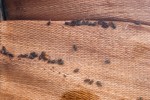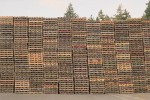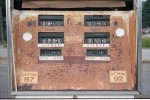Nov
30
2013
Images taken with the Pentax K-3 in challenging light, higher ISO settings and all hand-held. The point being that I would not have been able to capture these images in this way previous to having this camera. It simply is better than anything I’ve ever had before both in image quality and general camera performance. In this situation in the low light of this antique store it’s the ability of the sensor to capture fine details without digital noise interfering that impressed me. That coupled with the shake reduction system that seems improved but is difficult to quantify allowed me to just walk around taking pictures without need of the tripod I had brought.
Even Ricoh have a hard time saying how well the shake reduction works as it depends so much on the method of testing. From their own website they suggust Type: Sensor-Shift Shake Reduction with rotational compensation (3.5EV TBD) so 3.5 stops is the difference between shooting something at ISO 280 vs 3200 that is no small deal and is true for any lens you mount on the K-3.
1 comment | tags: Digital, Pentax | posted in Photography
Nov
27
2013

The Limited Edition Fully Automatic See-Thru 35mm Panoramic Camera… only it isn’t. Clearly it can’t be completely transparent, that wouldn’t work with film now would it? That’s not the only thing though, Ricoh used the term panoramic to refer to setting focus to infinity and the flash off, which isn’t what comes to mind when I think of a panorama. The clear plastic showing the cameras inner workings is the most conspicious thing about it but it’s also a decent camera from the time, though a little chunky.

1 comment | posted in Cameras, Photography
Nov
25
2013
I recently had occasion to spend two nights in Gatineau Quebec. The window of my room faced towards Ottawa and I used it to take a few pictures with my Pentax K-01 and Pentax Q. I did a little re-arranging of the furniture to make a comfortable chair shaped support for my cameras, and then used a two second timer to prevent camera shake.
no comments | posted in Photography
Nov
23
2013

I love the variety of design with older cameras despite the similarity of materials every one of these cameras is unique.
You can view the 288 Mpixel zoomable version by clicking on the thumbnail bellow (Warning it contains about 80Mbytes of data in total)

3 comments | tags: Cameras, Pentax | posted in Photography, Processing
Nov
21
2013

Some more Kodak Portra 400 images a film that I like the look from the more I see the results. Other Portra images and discussion can be seen here Kodak Portra 400
no comments | posted in Photography, Processing
Nov
19
2013

It was very popular for a time to include a panoramic mode on film point and shoot cameras. Whether using it was as popular I’m not so sure. The way it worked was that when the user selected the panoramic mode part of the film was masked off at the top and bottom leaving a wide aspect ratio image. The thing is this did nothing to change the actual angle of view so if the camera had its widest focal length of 38mm then that was how the image was shot. In fact the result is really to just waste possible film capture area. This camera does this as well but with a slight difference which I will explain in a moment. The Minolta Freedom Vista creates an image on the negative of 36mm X 13mm which is a 2.77 apect ratio. This is even wider than movie formats like CinemaScope or Panavision and is getting close to a 3 to 1 ratio. It’s enough of a dramatic change from normal film shooting that you need to modify your compositions.

For the crop mode on the point and shoots I mentioned the viewfinder typically showed the frame lines for a panoramic shot or blocked out the top and bottom of the viewfinder making it easier to compose in the wide format. Where the Minolta Freedom Vista differs and has an advantage over these implementations is that it has a fixed panoramic mode and has a 24mm wide-angle lens which produces images that look much more like they should be panoramic. In addition the viewfinder was built from the ground up to for the format and so shows a nice bright wide frame which is far superior to the ‘me too’ masking mode of other cameras.



no comments
Nov
15
2013
I loaded some Kodak Portra 400 into my trusty Pentax Z1p and took it with me on a trip into the Cariboo region of British Columbia. I’ve always tried to stay away from using 400 ISO film in daylight but this is touted as being extremely fine-grained so I relented. Technical details can be seen in Kodak Technical Publication e4050 . The film was upgraded in 2010 using technology previously used in the Vision motion picture line of film but I don’t have any samples from the previous formulation to compare, the film in its current state though is incredibly versatile. It costs me about $8 per roll vs $5.50 for Ektar so with Ektar being yet even finer grained it’s not a replacement for that film. compared to Fuji Superia 400, Portra 400 has a much tighter grain and less colour mottling and seems to have a much smoother tonal range.
Here are a couple of 100% crops from the film so you can see for your self. The negatives were scanned at 3200 DPI and would provide 11×14″ prints at 300DPI. From a normal viewing distance the grain would be visible but not unpleasantly so. With a very slight amount of processing in Lightroom this grain could be greatly reduced if that is what you wanted, I don’t.


Here are more images I hope you enjoy. On a side note I refered to Kodak’s Vision film earlier and I’ve purchased 4 rolls of Cine Still Film 800 Tungsten which is motion picture film processed and packaged for still photography I’m really looking forward to trying it out.
1 comment | tags: film, Kodak | posted in Photography, Processing
Nov
13
2013
With the acquisition of my latest camera the Pentax K-3 and the fact that I pre-ordered it and ended up being among the first people to receive one I felt I needed to do some testing to determine how far I can push it in terms of ISO performance. This camera is an upgrade to my Pentax K-7 DSLR at 14.6Mpixel but in between I also have my mirrorless K-01 with its 16Mpixel sensor. I thought I would share my findings and hope that you find them useful.
I set up a simple scene of my Minolta Super A, a camera with a lot of details, against a black background with a constant fluorescent light. I used the Pentax SMC 100 Macro WR lens on all three cameras and set the aperture to f13 each time while allowing the camera to vary the exposure with a -1EV bias set to compensate for all the black. The images are all shot in DNG RAW and taken as screen captures from Lightroom where I have set all noise reduction, both chroma and luminance, to 0. A setting I would never use in normal operation but makes things equal and accentuates the differences
Here are crops from the two DSLRs set to ISO 100 a sensor level where they all perform well with the K-3 producing an image with more detail.

But it’s the higher ISO’s that are going to start to show the differences between the sensors and their noise performance. Next I jump to 1600ISO where the 4-year-old K-7 starts to struggle but the newer sensors produce images that can easily have evidence of noise removed.


In the above image comparing the K-01 and the K-3 at 1600 ISO you can see that the K-3 appears to have slightly more chroma noise however that is something that can be completely mitigated with very slight noise reduction.
Next I will jump to 6400 ISO a place the K-7 has no business going to but where the K-01 and K-3 still are producing files that would clean up with some noise reduction.


Despite both being shot in RAW it seems that the K-01 is using some noise reduction within the camera so while the K-01 image has less noise it also has less detail even more so than the difference in resolutions affords.
Here is the K-3 vs the K-3 at 12800 ISO with noise reduction in Lightroom 5. The K-01 file has less noise but also less detail I would choose the more detailed K-3 image if asked for a preference

Here is the K-3 at 6400ISO vs the K-7 at 800 ISO where the distance separating them is more than 3 stops. This is a major improvement for me as when I’ve shot performaces in the past I have needed to balance shutter speed aperture and ISO in a clumsy dance at the edge of the K-7’s performance envelope. Those extra stops can go into a faster shutter speed or smaller aperture or both. And the fact that the K-3 focuses in light the K-7 is blind in only adds more usability.

As for the K-3 vs the K-01 they have similar noise performance up to about 6400ISO after which point the K-3 starts to appear more noisy but the K-3 continues to retain more detail through out all ISO’s.
In conclusion the K-3 is a major ISO performance upgrade over the K-7 and therefore also the K-20d by default but is less so over the 16Mpixel sensor in the K-01. This is of course only one aspect of the camera and hardly begins to touch on what a fantastic camera the K-3 is. For instance I used manual focus for this test for the simple reason that I wasn’t able to set the focus exactly where I wanted with the K-7 or K-01 but with the K-3 I was able to easily select the active point from any of the 27 placing it where I needed. This is such a major upgrade for macro photography it can not be over stated.
4 comments | posted in Photography, Processing
Nov
12
2013
2 comments | posted in Painting






























































































